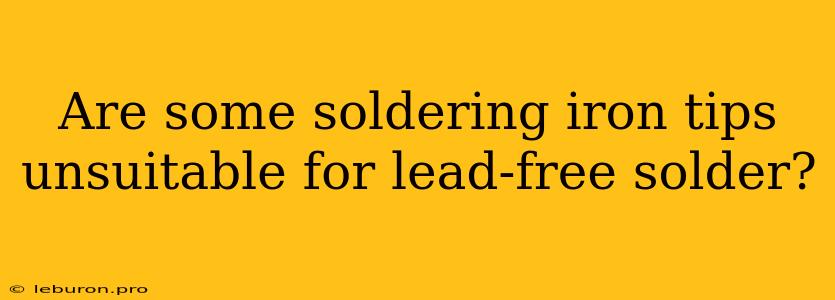The transition to lead-free solder has brought about significant changes in the electronics manufacturing industry, and one aspect that has garnered attention is the compatibility of soldering iron tips. While many soldering iron tips can be used with both lead-free and leaded solder, there are certain factors to consider to ensure optimal performance and longevity of the tip. This article delves into the reasons why some soldering iron tips might be unsuitable for lead-free solder and provides insights into selecting the right tip for your soldering needs.
The Impact of Lead-Free Solder on Soldering Iron Tips
Lead-free solder, commonly composed of tin, silver, and copper alloys, exhibits different melting temperatures and wetting properties compared to leaded solder. These differences can significantly affect the performance and lifespan of soldering iron tips.
Higher Melting Temperature
One of the key challenges posed by lead-free solder is its higher melting temperature. Lead-free solder typically melts at around 217°C (423°F), whereas leaded solder melts at around 183°C (361°F). This higher melting temperature puts more stress on the soldering iron tip, potentially leading to premature wear and tear.
Wetting Properties
Lead-free solder also exhibits different wetting properties compared to leaded solder. Wetting refers to the ability of the solder to flow smoothly and evenly across the surface of the components being soldered. Lead-free solder tends to wet less readily than leaded solder, which can result in poorer solder joints and increased tip oxidation.
Unsuitable Soldering Iron Tips for Lead-Free Solder
While not all soldering iron tips are unsuitable for lead-free solder, certain types are better suited for leaded solder and may experience problems when used with lead-free solder. Here are some examples:
Iron-Plated Tips
Iron-plated tips are commonly used with leaded solder due to their affordability and relatively good performance. However, they are not recommended for lead-free soldering. The iron plating can react with lead-free solder, leading to tip degradation and poor solder joint quality.
Copper Tips
Copper tips are another type that may not be ideal for lead-free solder. While they offer good thermal conductivity, they are prone to oxidation when exposed to high temperatures. This oxidation can hinder heat transfer and lead to inconsistent soldering performance.
Nickel-Plated Tips
Nickel-plated tips are generally considered more suitable for lead-free soldering than iron-plated or copper tips. The nickel plating provides better resistance to oxidation and corrosion, making it more durable at the higher temperatures required for lead-free solder.
Selecting the Right Soldering Iron Tip for Lead-Free Solder
When choosing a soldering iron tip for lead-free soldering, consider the following factors:
Tip Material
Tips made of materials like nickel-plated copper, or iron-plated copper with a nickel coating are often recommended for lead-free soldering. These materials offer better resistance to oxidation and provide a more consistent heat transfer.
Tip Shape
The shape of the soldering iron tip also plays a crucial role in its performance. For lead-free soldering, tips with larger surface areas are generally preferred. This larger surface area helps to distribute heat more evenly and reduces the risk of overheating the components being soldered.
Tip Temperature
When soldering with lead-free solder, it's essential to use the correct tip temperature. The tip should be hot enough to melt the solder but not so hot that it damages the components. Experimentation and experience will help you determine the optimal temperature for your specific soldering needs.
Maintaining Your Soldering Iron Tips for Lead-Free Solder
To ensure optimal performance and longevity of your soldering iron tips when using lead-free solder, follow these maintenance practices:
- Clean your tip regularly using a tip cleaner or a damp sponge. This will remove any oxidation or residue that can hinder heat transfer.
- Tin your tip by applying a thin layer of solder to the tip. This helps to prevent oxidation and promotes better heat transfer.
- Avoid overheating your tip by using the appropriate temperature setting for the solder and components being used.
Conclusion
The transition to lead-free solder has brought about changes in the electronics manufacturing industry, including the need to select appropriate soldering iron tips. While some soldering iron tips are suitable for both leaded and lead-free solder, others, like iron-plated or copper tips, may not perform optimally with lead-free solder. By considering the factors discussed in this article and selecting the right tip material, shape, and temperature, you can ensure reliable and efficient soldering performance when using lead-free solder. Remember to maintain your soldering iron tips properly to extend their lifespan and ensure the quality of your soldering work.
